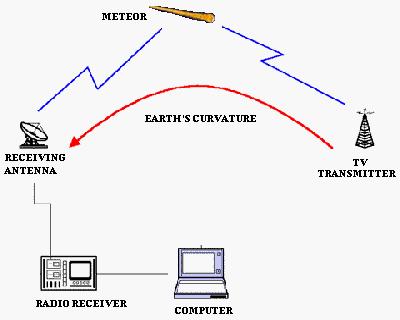RADIO OBSERVATIONS OF METEORS
Since 2001 to 2004 I was the leader of the radioastronomy group of the Associazione Friulana di Astronomia e
Meteorologia (AFAM). Among several experiments, I was particularly
interested in the radio observation of meteor activity.
 Observing meteors in
the radio band is a powerful technique to perform a complete monitoring
on a 24 hours basis, efficiently overcoming the constraints affecting
visual observations (mainly weather conditions and the day-night
cycle).
Observing meteors in
the radio band is a powerful technique to perform a complete monitoring
on a 24 hours basis, efficiently overcoming the constraints affecting
visual observations (mainly weather conditions and the day-night
cycle).
The method used to detect meteors was the classical forward scatter technique. A distant
(~1000 km) TV transmitter emits radio waves that under normal
conditions cannot be detected by a receiving antenna due to Earth's
curvature. However, if a meteor passes more or less at half the
receiver-transmitter distance, its ionized trail is able to reflect
transmitter waves to the receiving antenna and produces a radio echo
(see the scheme on the right). The antenna is connected by a coaxial
cable to a radio receiver, which finally redirects the signal to a
computer for automated meteor detection and counting.
I recommend to visit the radio page of the International Meteor
Organization for a lot of information on this observing technique.
As for the radio meteor station in use at the AFAM observatory, the
equipment was precisely composed by a 4-elements
Yagi antenna built to operate in the VHF band. A professional ICOM R-9000 receiver connected to a PC running Windows 98 allowed the detection of radio echoes from meteors fainter than the faintest stars visible with the unaided eye. The automated counting of meteors was performed with an adapted version of MOP (Meteor Observation Project), an FFT-based detection software written by Andreas and Michael Hagen.
Observations realized with the meteor station at AFAM Observatory
In principle the meteor station was able to operate on a continous basis over periods of several weeks, with only few interruptions for basic maintenance. However, the interest was mainly focused on the dates around the peaks of major meteor showers. In the following you can see some results of meteor counts (click on the links):
- Activity graph of the Leonids meteor shower in november 2002: the total reflection time vs time is
reported from november 14 to 22. An activity peak in the morning of november 19
is evident, in perfect agreement with the predictions of the
theoretical models. Unfortunately, a sudden crash of Windows 98 prevented the detection of a second peak a few hours after the first one.
- Activity graphs of the Geminids
meteor shower in december 2002. The first graph reports meteor counts
vs time from december 10 to 16. Black points and lines refer to all the
detected radio echoes, while blue points and lines only refer to echoes
with duration larger than 1 sec (produced by brighter meteors). A broad activity peak in the night 13-14 is evident. The second graph, instead,
shows the total reflection time vs time in the same week of december.
The dotted line in this graph is the radio
observability function of the shower, which modulates the number
of observed counts depending on the elevation and azimuth of the shower radiant and on the direction defined by the TV transmitter and the receiving antenna.
- Activity graphs of the Quadrantids
meteor shower in january 2003.
The first graph reports meteor counts vs time from january 1 to 7.
Black points and lines refer to all the detected radio echoes, while
blue points and lines only refer to echoes with duration larger than 1
sec. The activity peak in
the morning of day 4 is evident. The second graph, instead, shows the total
reflection time vs time in the same week of january. The dotted line in
this graph is the radio
observability function of the shower (see above).
All the radio observations were published in the monthly
Radio Meteor Observation Bulletins (RMOBs), an initiative of radio
meteor enthusiasts collecting data from meteor stations spread in the whole world.
Here there is a list of contributions to the RMOBs in 2002 and 2003:
August 2002,
September 2002,
October 2002,
November 2002,
December 2002,
January 2003,
March 2003,
April 2003,
May 2003,
September 2003,
October 2003,
November 2003.
The meteor counts at the AFAM meteor station were also published in WGN, the
Journal of the International Meteor Organization. In particolar, I published together with my friends of the radioastronomy group the results of the detection of the 2002 Ursids outburst (see WGN, volume 31, pages 29-30 (2003)). More results (previously reported in the RMOBs) on other meteor showers were also analyzed and published in WGN by Alistair McBeath (see WGN, volume 31, page 64 (2003); WGN, volume 31, page 111 (2003); and WGN, volume 33, page 101 (2005)), and Hiroshi Ogawa (International Project for Radio Meteor Observations; see WGN, volume 30, page 225 (2002)).
Since 2005 Diego Ganzini took the direction of AFAM radioastronomy group, whose operations continued until 2007. If you are interested on the several activities carried on at the AFAM observatory you can have a look at the old web page (only in Italian) of the radioastronomy group.
 Observing meteors in
the radio band is a powerful technique to perform a complete monitoring
on a 24 hours basis, efficiently overcoming the constraints affecting
visual observations (mainly weather conditions and the day-night
cycle).
Observing meteors in
the radio band is a powerful technique to perform a complete monitoring
on a 24 hours basis, efficiently overcoming the constraints affecting
visual observations (mainly weather conditions and the day-night
cycle).